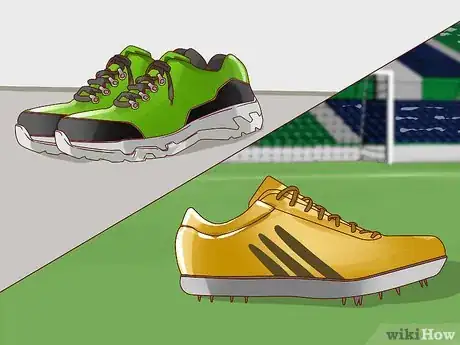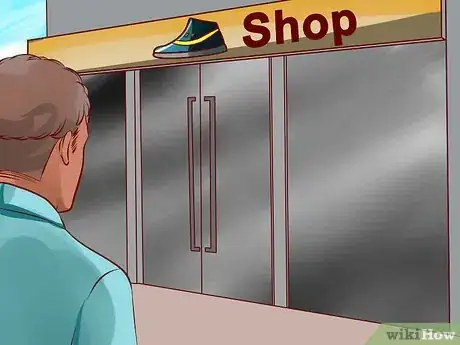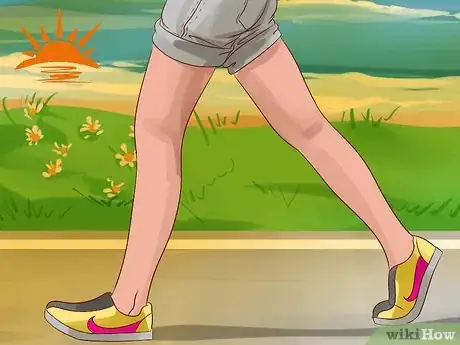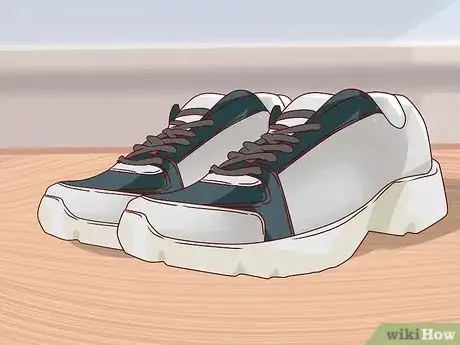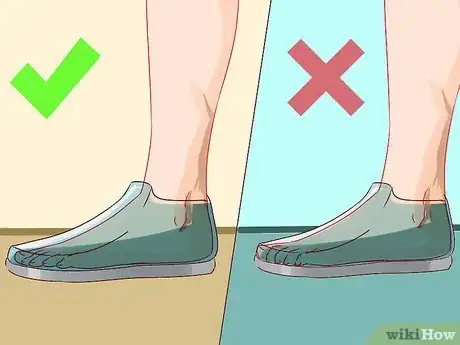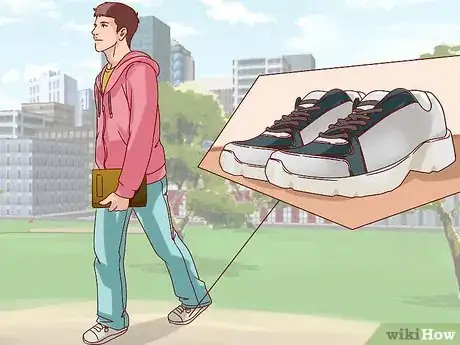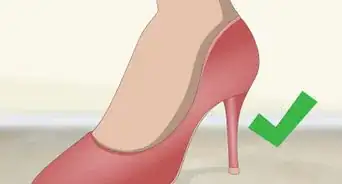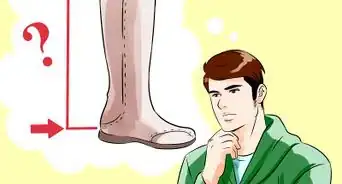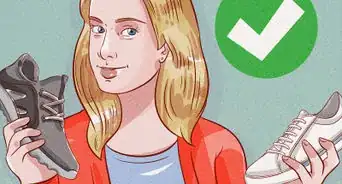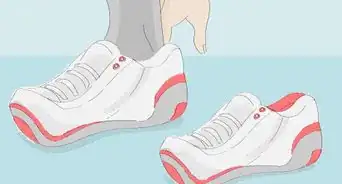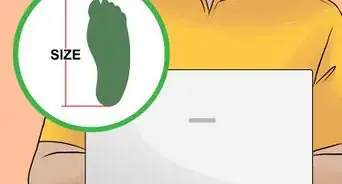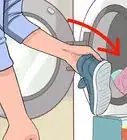This article was co-authored by Kai Ng. Kai Ng is a USATF and RRCA Certified Running Coach at Run Coach Kai. Kai has competed in over 55 races and over 15 marathons, and has trained with 16x USA and World record holder Patti Catalano Dillonso. He specializes in coaching runners of all levels and showing people that everyone can be a runner. Kai is committed to helping his clients reach their goals by showing them how to run with proper form and holding them accountable to train consistently.
There are 14 references cited in this article, which can be found at the bottom of the page.
wikiHow marks an article as reader-approved once it receives enough positive feedback. In this case, several readers have written to tell us that this article was helpful to them, earning it our reader-approved status.
This article has been viewed 124,284 times.
Running in the wrong shoes can be a recipe for disaster, especially if you plan on running distance or on uneven terrain. A poor choice in footwear can cause foot pain, back pain, Achilles tendinitis, runner's knee, and other conditions. [1] Before you choose your shoes, you'll need to take into account the terrain you run on, your running style, and your personal tastes. Then you'll be ready to purchase and take your first steps in your new running shoes, and when you do, you won't regret the time you spent.
Steps
Determining Your Needs
-
1Consider the surface you will be running on.[2] This will significantly influence what kind of shoe will be best for your foot. For instance, if you are running on a track or court specially designed to be flat and offer grip, you won't need extra traction on your shoe. Generally:
- Road/track running will require less traction and lighter weight.
- Trail running should have good traction, support, and cushion for uneven ground.
EXPERT TIPTyler Courville is a brand ambassador for Salomon Running. He has run in 10 ultra and mountain races across the United States and Nepal, and won the 2018 Crystal Mountain Marathon.Professional Runner
 Tyler Courville
Tyler Courville
Professional RunnerTip from Tyler Courville, Ultra and Mountain Runner: "Gear that’s good on roads isn’t necessarily good in the mountains, so be specific about what shoe you need for the terrain."
A Personal Cautionary Tale: "I remember I bought this pair of trail shoes once. I ran with them on roads and thought they were phenomenal. Then, I wore them for a technical mountain run in Montana, and in the middle of the race, I discovered that they weren't suited for technical terrain — my foot was sliding all over. I ended up having to tie them so tight to keep them in place that I gave myself tendinitis on the top of my foot. It's a good lesson to know the terrain you're running if you’re doing anything in the mountains, and test your gear ahead of a big race."
-
2Identify the kind of running you will do.[3] It's important that you don't accidentally buy athletic shoes that aren't designed expressly for running. There are many different categories of athletic shoes, like training shoes or walking shoes, though these are no ideal for indoor, track, cross country, sprint, or distance running.[4]Advertisement
-
3Receive a professional evaluation for your feet. Many specialty running stores now have equipment that can analyze your gait (how you walk/run) and your foot type. This will help you to know whether or not you need support to prevent your foot from rolling inward (also called pronating). Though there are many different foot-types, the main three are:
- Neutral footed runners, where your foot comes into contact with the ground toward the middle of the foot.
- Overpronation, where your foot rolls inward too far.
- Underpronation, where your foot does not roll in far enough (optimal is about 15% give). This results in inefficient impact dispersion, and it causes the lateral (outside) part of your feet to do more more work than necessary at the push off.[5]
-
4Take your weight into account. The heavier you are, the greater the impact between your foot and the ground will be.[6] This increase in impact may require you to purchase shoes with additional support, even if your foot-type is neutral and you normally would not be advised in that way.
- You may want to bring this attention to your doctor or the expert helping you decide on your shoes, especially if you already feel foot, leg, or back pain.
-
5Consult a doctor about injuries and physical impairments. You may have an injury that influences your gait, or a physical impairment that does the same. In both these instances, you should check with your doctor as to what kind of shoes would offer the best support and running experience with you.
Purchasing Your Running Shoes
-
1Go to a specialty running shoe store for your fit.[7] Different designs in shoes can drastically change the fit and feel of it.[8] Sometimes the materials used in making a shoe can make it feel uncomfortable, stiff, or heavy. Prevent this from happening by trying on many different pairs at a physical store.
-
2Try on your shoe later in the afternoon. This may sound silly, but over the course of the day, your feet become swollen from physical activity. By trying on your shoe later in the day, you will prevent buying a shoe that is too small. You might also consider:
- Trying on shoes after a run. This will simulate the max size of your foot.
- If you have orthotics or generic supports, bring these with you. These should be taken into consideration during your fitting.
-
3Aim for shoes that are snug. If you feel pinching or uncomfortable rubbing, that shoe is likely not your best fit.[11] Over the course of your run, your feet will swell in size. Also, over the course of your running, the uncomfortable features will likely become worse with each mile, causing you unnecessary discomfort.
- Tie the shoes and walk around after slipping them on your feet. Maybe even take a few laps around the store, if permitted. This way, you'll have a better feel for fit of the shoe.[12]
-
4Consider a half-size larger.[13] The strain put on feet and the resulting swelling means that most runners have to buy a shoe that is a half size larger than their normal street shoe. A good rule of thumb is to test your shoe by:
- Slide your foot forward in your shoe.
- Insert a finger in between your foot and the heel of the shoe.
- Verify there is a finger's width of space to prevent your shoes from being cramped when towards the end of a run.
-
5Ask questions about the features of your shoe.[14] A good pair of running shoes can be expensive, so you might want to avoid paying extra for unnecessary features. Ask the shoe clerk helping you about features like:
- Vents in the shoe.
- The shape or configuration of the bottom of the shoe.
- Transparent parts that show an "air bladder" for support.
-
6Keep an open mind. Even if there is a shoe that looks perfect for you, that's just in your color, do not let appearances deceive you into buying an uncomfortable shoe. You will be spending a lot of time and earning a lot of sweat in your new shoes.[15] Try on many, and note the pairs that feel best.[16]
-
7Inquire about specializations within your shoe type.[17] Even if you are buying a specialty shoe, like a stability shoe or a motion control shoe, inside each of these categories are even more specializations. For example, a stability forefoot striking shoe will not serve a heel striker well.
- Those who are prone to injury might consider maximalist running shoes, which are intended to even further reduce the force of impact.[18]
-
8Break in your shoes to prevent blisters and increase comfort. While your shoes adjust to your feet and your feet adjust to your new shoes, there will probably be some very slight friction which could cause blisters. Begin breaking in your new shoes by going on shorter runs or walking. This way you run less of a risk of developing blisters.
- Some recent studies have suggested that, especially for athletic and running shoes, you should be able to put your new footwear on immediately and be comfortable.[19]
-
9
Expert Q&A
-
QuestionWhy is it necessary to buy the right shoes for running?
 Kai NgKai Ng is a USATF and RRCA Certified Running Coach at Run Coach Kai. Kai has competed in over 55 races and over 15 marathons, and has trained with 16x USA and World record holder Patti Catalano Dillonso. He specializes in coaching runners of all levels and showing people that everyone can be a runner. Kai is committed to helping his clients reach their goals by showing them how to run with proper form and holding them accountable to train consistently.
Kai NgKai Ng is a USATF and RRCA Certified Running Coach at Run Coach Kai. Kai has competed in over 55 races and over 15 marathons, and has trained with 16x USA and World record holder Patti Catalano Dillonso. He specializes in coaching runners of all levels and showing people that everyone can be a runner. Kai is committed to helping his clients reach their goals by showing them how to run with proper form and holding them accountable to train consistently.
Certified Running Coach If you use the wrong size shoe for running, you may get ankle pain. Sometimes if you tie the shoelaces too tight, it can suffocate the ankles a bit and cause pain. If the shoes are broad in the front and narrow at the heel, they may make running uncomfortable.
If you use the wrong size shoe for running, you may get ankle pain. Sometimes if you tie the shoelaces too tight, it can suffocate the ankles a bit and cause pain. If the shoes are broad in the front and narrow at the heel, they may make running uncomfortable. -
QuestionWhy should runners not do deep squats?
 Kai NgKai Ng is a USATF and RRCA Certified Running Coach at Run Coach Kai. Kai has competed in over 55 races and over 15 marathons, and has trained with 16x USA and World record holder Patti Catalano Dillonso. He specializes in coaching runners of all levels and showing people that everyone can be a runner. Kai is committed to helping his clients reach their goals by showing them how to run with proper form and holding them accountable to train consistently.
Kai NgKai Ng is a USATF and RRCA Certified Running Coach at Run Coach Kai. Kai has competed in over 55 races and over 15 marathons, and has trained with 16x USA and World record holder Patti Catalano Dillonso. He specializes in coaching runners of all levels and showing people that everyone can be a runner. Kai is committed to helping his clients reach their goals by showing them how to run with proper form and holding them accountable to train consistently.
Certified Running Coach Runners should protect their knees. If you are a runner, you should not do squats past 90 degrees or when your quads or thighs are parallel to the ground. Do not overuse your knees by doing deep squats.
Runners should protect their knees. If you are a runner, you should not do squats past 90 degrees or when your quads or thighs are parallel to the ground. Do not overuse your knees by doing deep squats. -
QuestionMy son is 7 and he complains about heel pain if he runs a lot. Which kind of shoe should we buy?
 Community AnswerIn this case, it might not be the type of shoe that is causing the pain. Consider going to a doctor to find out what's wrong and/or get a prescribed sole for the shoe.
Community AnswerIn this case, it might not be the type of shoe that is causing the pain. Consider going to a doctor to find out what's wrong and/or get a prescribed sole for the shoe.
References
- ↑ http://www.hopkinsmedicine.org/healthlibrary/conditions/orthopaedic_disorders/foot_pain_and_problems_85,P00914/
- ↑ https://www.aofas.org/footcaremd/how-to/footwear/Pages/Selecting-Athletic-Shoes.aspx
- ↑ http://www.webmd.com/fitness-exercise/how-choose-athletic-shoes?page=1
- ↑ https://www.aofas.org/footcaremd/how-to/footwear/Pages/Selecting-Athletic-Shoes.aspx
- ↑ http://www.runnersworld.com/running-shoes/pronation-explained
- ↑ http://www.nhs.uk/Livewell/foothealth/Pages/Choosingsportshoes.aspx
- ↑ https://www.aofas.org/footcaremd/how-to/footwear/Pages/Selecting-Athletic-Shoes.aspx
- ↑ Kai Ng. Certified Running Coach. Expert Interview. 12 February 2021.
- ↑ http://runblogger.com/2012/10/shoes-matter-running-shoes-can.html
- ↑ http://runnersconnect.net/running-training-articles/choosing-the-right-running-shoes/
- ↑ Kai Ng. Certified Running Coach. Expert Interview. 12 February 2021.
- ↑ https://www.aofas.org/footcaremd/how-to/footwear/Pages/10-Points-of-Proper-Shoefit.aspx
- ↑ http://www.webmd.com/fitness-exercise/how-choose-athletic-shoes?page=2
- ↑ http://www.webmd.com/fitness-exercise/how-choose-athletic-shoes?page=2
- ↑ http://well.blogs.nytimes.com/2015/08/05/choosing-the-right-running-shoes/
- ↑ Kai Ng. Certified Running Coach. Expert Interview. 12 February 2021.
- ↑ http://www.webmd.com/fitness-exercise/how-choose-athletic-shoes?page=2
- ↑ http://www.nytimes.com/2015/02/17/sports/forget-barefoot-many-seek-cushioning-in-running-shoes.html
- ↑ http://www.webmd.com/fitness-exercise/how-choose-athletic-shoes?page=2
- ↑ http://www.adidas.com/us/help-topics-returning.html
- ↑ https://www.newbalance.com/cs-returnlabel
About This Article
To choose running shoes, go with shoes that have good traction and support if you'll be running on trails or uneven ground. If you only plan on running on roads or tracks, don't worry about getting shoes with extra traction. Also, make sure you look for athletic shoes that are designed specifically for running as opposed to just walking or training. When you're trying shoes on, look for something that's a half-size too big since your feet swell a little bit when you run. To learn how to break in new running shoes, scroll down!
